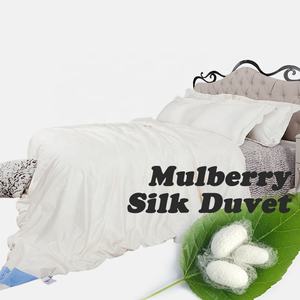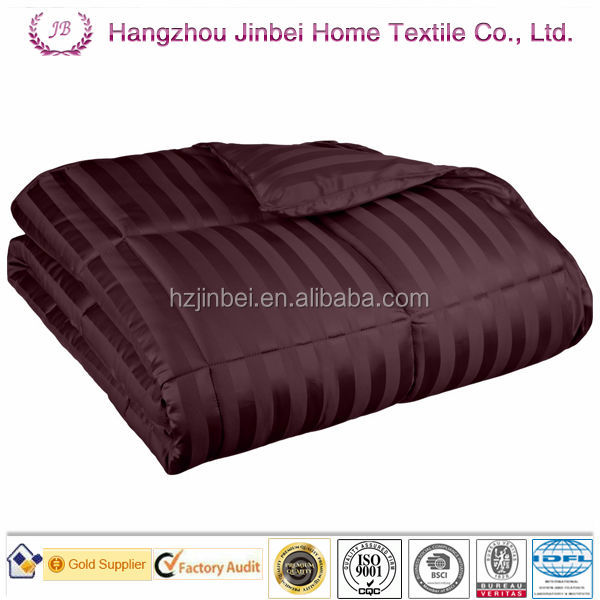Title: A Comparative Analysis of Mulberry Silk and Down Blankets: Which One is Superior?
Mulberry silk and down blankets are two popular choices for keeping warm during the winter months. While both materials offer excellent insulation and comfort, they have some distinct differences that set them apart. Mulberry silk is made from the cocoons of silkworms and has a luxurious feel to it. It is hypoallergenic and breathable, making it a great choice for people with allergies or sensitive skin. However, mulberry silk can be more expensive than down blankets.Down blankets, on the other hand, are made from feathers collected from birds such as ducks or geese. They are highly compressible and provide exceptional warmth without being too heavy to carry around. Down blankets are also more affordable than mulberry silk, making them a popular choice among budget-conscious consumers. However, down blankets can be less breathable than mulberry silk and may not be suitable for people with allergies or sensitive skin.In conclusion, both mulberry silk and down blankets have their advantages and disadvantages. If you value luxury and breathability over cost and weight, mulberry silk may be the better choice. If you prioritize warmth and affordability, a down blanket may be more suitable for you. Ultimately, the decision comes down to personal preferences and needs.
In the world of bedding, two materials that have been revered for their comfort and warmth are mulberry silk and down blankets. Both of these materials have been used for centuries, with mulberry silk being a popular choice in Chinese culture and down blankets being a staple in many parts of North America and Europe. However, when it comes to choosing between these two materials, which one is truly superior? In this article, we will explore the benefits and drawbacks of both mulberry silk and down blankets to help you make an informed decision.
Mulberry Silk: A Natural Wonder
Mulberry silk, also known as silkworm silk or sericulture silk, is made from the cocoons of silkworms. It is one of the most luxurious fabrics in the world, prized for its softness, durability, and natural sheen. The process of making mulberry silk involves harvesting the cocoons, extracting the silk fibers, and weaving them into textiles.
Advantages of Mulberry Silk:

1. Softness and Comfort: Mulberry silk is renowned for its incredible softness and comfort, making it ideal for bedding items like pillows, sheets, and quilts. The smooth texture of silk fibers helps to regulate body temperature, keeping you cool in summer and warm in winter.
2. Hypoallergenic: Mulberry silk is hypoallergenic, meaning it is less likely to cause allergic reactions than other materials like wool or cotton. This makes it an excellent choice for those with sensitive skin or allergies.
3. Durability: Mulberry silk is incredibly durable, with a lifespan of several decades if properly cared for. It can withstand frequent washing and use without losing its beauty or softness.
4. Eco-friendly: Mulberry silk production is a sustainable and eco-friendly process. It doesn't require harmful chemicals or pesticides, and the worms themselves are a natural source of nutrition for farmers.
Down Blankets: A Warm and Cozy Choice
Down blankets are made from the feathers of birds such as ducks, geese, and chickens. They are lightweight, breathable, and highly insulating, making them an excellent choice for colder climates. Down blankets are typically filled with synthetic materials like polyester or down blends to enhance their warmth and durability.
Advantages of Down Blankets:
1. Warmth: Down blankets are known for their exceptional warmth and insulation, keeping you cozy and comfortable even in freezing temperatures. They are ideal for use in bedrooms, living rooms, and common areas where additional heat is needed.
2. Breathability: Down blankets are designed to be both warm and breathable, thanks to their unique structure. The small air pockets inside the feathers allow moisture to escape, keeping you dry and comfortable even on humid days.

3. Lightweight: Down blankets are lightweight and easy to carry around, making them perfect for travel or storage. They don't take up much space and can be easily packed away during warmer seasons.
4. Durable: While not as durable as mulberry silk, down blankets can still last for several years with proper care. They can be cleaned by machine washing or hand-washing, depending on the type of fill (synthetic or natural).
Disadvantages of Down Blankets:
1. Allergies: Some people may be sensitive to the chemicals used in down processing or fillings like synthetic fibers. These substances can cause allergic reactions such as sneezing, itching, or difficulty breathing.
2. Durability: While down blankets can last for several years with proper care, they may not be as durable as mulberry silk. The small air pockets inside the feathers can become compressed over time, reducing their insulation properties and making them less effective at retaining heat.
3. Environmental Impact: Down farming can have a significant environmental impact due to the need for large quantities of water and feed for the birds. Additionally, the disposal of down waste can contribute to pollution if not managed properly.
Conclusion: A Personal Choice Based on Your Needs and Preferences
So, which material is superior between mulberry silk and down blankets? The answer ultimately depends on your individual needs and preferences. If you prioritize softness, comfort, and sustainability, then mulberry silk may be the better option. Its hypoallergenic properties, natural beauty, and eco-friendliness make it an excellent choice for those with sensitive skin or environmental concerns. On the other hand, if you value warmth, breathability, portability
Articles related to the knowledge points of this article:
The Best Storage Bags for Your Down Comforter
Putuo District Down-filled Quilt Suppliers: Phone Numbers and More
Title: The Art of Crafting: An Insight into the Making of Woodpecker Down Quilts
Sam and Yangs Down Duvet: A Comparative Review
Title: Chinese-made vs. imported down comforters: a comparative analysis



